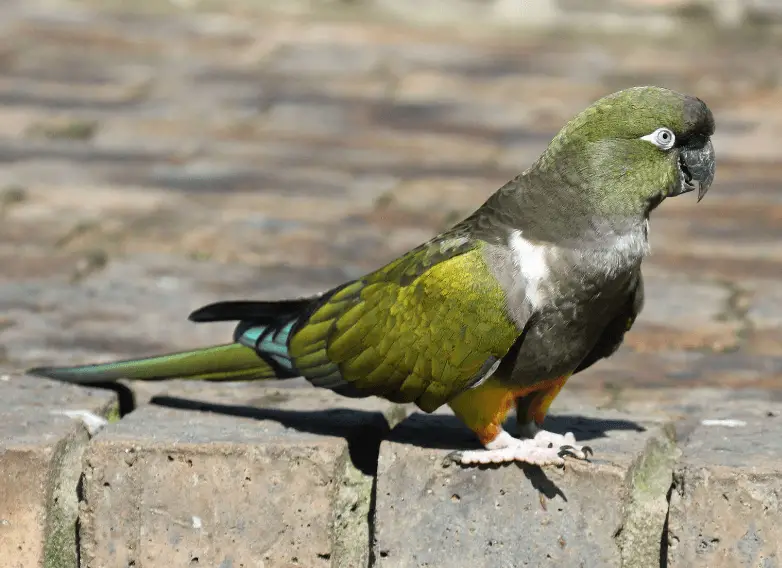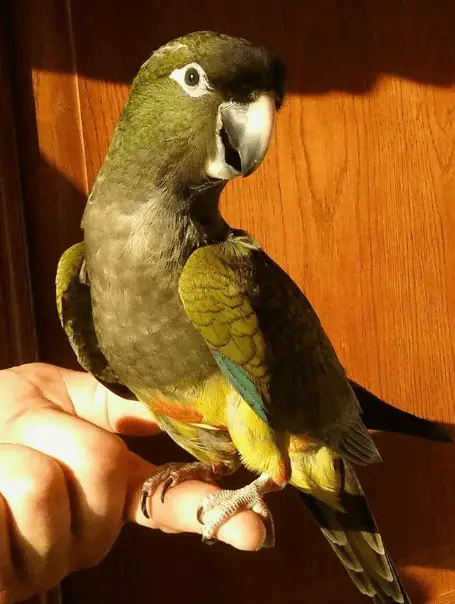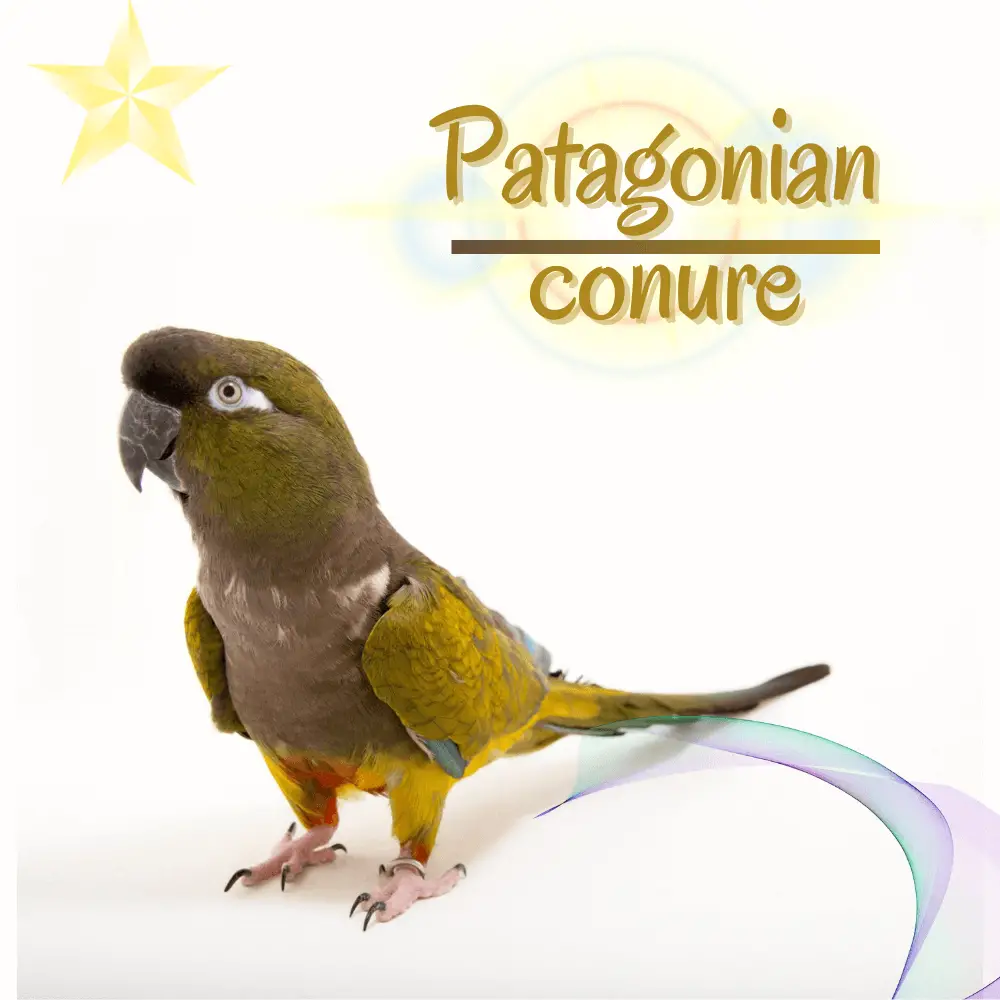In Patagonian conure, the forehead, hood, lores, cheeks, and nape are olive-brown with a slight yellowish tinge.
The sides of the neck, mantle, and back are also olive-brown, contrasting with the rump and upper tail coverts which display a bright canary-yellow color.
The scapulars are brown, more or less infiltrated with blue. The primary coverts are blue-turquoise, and the other coverts are brownish-olive yellow.
Primary and secondary flight feathers are blue with dark borders. The underwing- coverts are olive-yellow. The underside of the flight feather is brown.
The breast presents an olive-brown color except for the central zone and the lateral zone which form a creamy-white band.
The rest of the underparts are canary yellow except the center of the belly which bears a large circular red-orange spot. The upper tail feathers are brown with a faint blue tinge near the rachis. The underside of the tail is brown.
The bill varies from sooty gray to black. The bare skin surrounding the eye is whitish. The irises are pale yellow, the legs light brownish-yellow. The sexes are identical. Immatures have a horny upper mandible and brown irises.
The Patagonian conure has everything going for it, its great fault is that it is noisy (shrilly and sometimes incessant cries). It is a bird to which one attaches itself very quickly, it adores the contact, that one pays attention to it. He is an extremely affectionate conure who loves to snuggle up to his human. It is almost a fusional link that can take place between humans and the Patagonian Parakeet.
Pay attention to the games you offer him, he is a bird that loves to nibble.
Family: Psittacidae
Genus: Cyanoliseus
Scientific name: Cyanoliseus patagonus
Common name: Patagonian conure, Patagonian parakeet
Origin: South America
Patagonian conure size: 43-47 cm
Patagonian conure lifespan: 25-30 years
Subspecific indications 4 subspecies
Cyanoliseus patagonus patagonus (c and se Argentina)
Cyanoliseus patagonus andinus (nw Argentina)
Cyanoliseus patagonus conlara (wc Argentina)
Cyanoliseus patagonus bloxami (c Chile)
Patagonian conure talking

Patagonian conures are very noisy birds, they utter a disyllabic, shrill “scree-ah, scree-ah”. When alarmed, they say powerful “gyeee gyeee gyee”.
The cries they produce when they are in groups in burrows sound to our European ears like the cries of black-headed gulls (Larus ridibundus).
Habitat
Patagonian conures frequent dry plains and patches of small shrubs that grow in mountain grassy areas up to 2000 meters above sea level.
They are also found in arid woodland savannahs and in open Chaco areas near waterways. These birds can also be observed in places where thorny bushes and columnar cacti abound, they willingly settle in pastures and on cultivated land.
Patagonian conures are never far from rivers and waterholes. The trees on which they prefer to perch are the yellow-barked Chañars (Geoffroea decorticans) and the mimosa of the genus Prosopis.
Behavior

Patagonian conures are highly gregarious birds, forming flocks sometimes exceeding 1000 individuals.
Patagonian conure adults, establish common roosts in the trees, on the electric wires on the outskirts of the cities, and in the tunnels which are initially planned for nesting.
These birds are subject to local movements. In the month of April, they leave the cliff regions where they nest and they do not return there until the beginning of September. In winter, southern populations begin a short northward migration.
Patagonian conure diet
Patagonian conures have a vegetarian diet. The menu varies considerably according to the seasons: in winter, these birds mainly eat seeds that they find on the ground or in the giant thistles.
At the end of spring and in summer, they ingest fruits such as those of Chañars with yellowish bark (Geoffroea decorticans), berries of wolfberries (Lycium salsum), and cacti.
According to a study carried out in terms of percentages, fruit represents 2% of the menu in November-December, 74% in January, 25% in February, 35% in March, and only 8% in April.
Patagonian conure for adoption
SOURCE: SUBBALAKSHMI SASTRY
Conure nesting behavior
The nesting season extends from September to February. Patagonian conures nest in colonies .
They dig burrows in limestone, sandy or earthy cliffs, often at a fairly substantial height, which gives them a vast panorama of the surroundings.
The excavations are close to each other and sometimes they communicate with each other. The nesting site is always located at a short distance from a river or a watercourse. The laying includes 2 to 4 eggs which are incubated for 24 or 25 days.
In the province of San Luis, egg deposition peaks during the wet season, from November to December. In Chile, Patagonian conures lay eggs slightly earlier.
The chicks are altricial. In captivity, their stay in the nest lasts 8 weeks, but in the wild, they remain dependent on their parents for a very long period which can extend for several months
Distribution

As its name indicates, this species is native to the south of the South American continent. Its area of distribution covers the provinces of central and northern Argentina, from the north of Santa Cruz to La Rioja, passing through Rio Negro, La Pampa, Buenos Ayres, and Cordoba.
She also lives in southern Uruguay. An isolated population is settled in central Chile. Four breeds are officially recognized: C. p. patagonus (central and southeastern Argentina, occasionally wintering in Uruguay) – C. p. andinus (northwestern Argentina in the provinces of Catamarca, Tucumàn, Salta, La Rioja, San Juan and Mendoza) – C. p. contora (central-western Argentina, provinces of San Luis and Cordobà) – C. p.
Protection
In central Argentina, this species is still locally common or abundant. Elsewhere, i.e. in the province of Cordoba and east of Buenos Aires, it is rather sparse or even rare.
The bloxami race once considered widespread in the central provinces of Chile, is now endangered, occupying only a small area and being estimated at less than 3000 adults. Given its range of nearly 1 million square kilometres, the Patagonian conure is listed as “Least Concern” by Birdlife and the IUCN.

